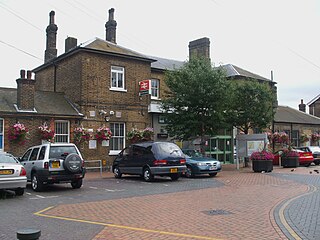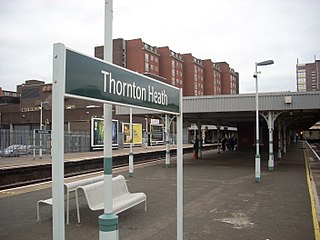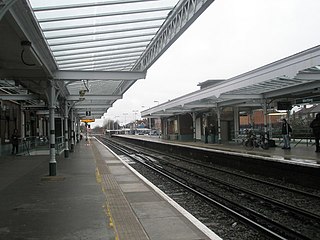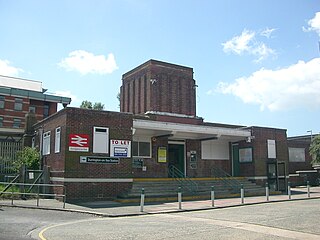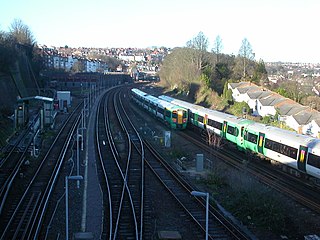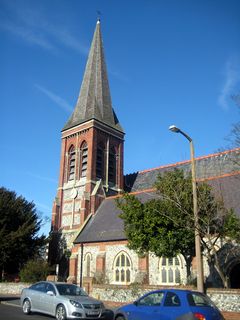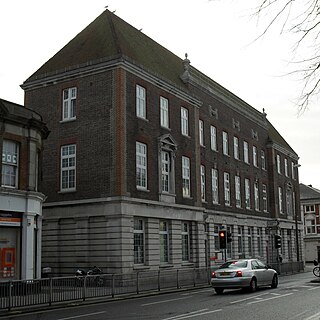Road



Worthing is served by several major roads. [1] The A24 runs to Horsham, Dorking, Leatherhead and London; the A27 serves Brighton and Portsmouth; and the A259 runs along the coast to Littlehampton, Chichester, Brighton, Hastings and Folkestone. The A27's predecessor was the Roman road between Chichester and Brighton. The present route, south of this ancient road, became established in the 17th century. The borough has a road network of more than 180 miles (290 km). [2]
A turnpike was opened in 1803 to connect Worthing with London, [3] [4] and similar toll roads were built later in the 19th century to connect nearby villages. [4] [2] Stagecoach traffic grew rapidly until 1845, when the opening of a railway line from Brighton brought about an immediate decline. [5] The former turnpike is now the A24, a primary route which runs northwards to London via Horsham and connects Worthing with the M25 motorway.
Worthing's remoteness from London and the major roads and coach routes of Sussex was alleviated in 1803, when a turnpike was opened between the seafront and West Grinstead via Findon. [3] [4] A tollgate stood near the present Teville Gate shopping centre between 1804 and 1845. Other tollgates in Goring, Heene and East Worthing served later turnpikes in those areas. [2] [4]
Until 1803, the nearest boarding point for stagecoaches was Steyning, [5] but coaches ran regularly to London soon after the turnpike opened. The initial service of three per week in summer only was upgraded to a daily service all year, leaving at 7.00am. [6] [7] The journey took about seven hours and cost 11/- (£50 as of 2021) [8] for an uncovered seat. [5] Coaches also ran to Brighton and Arundel, [9] and by 1832 there were 24 departures and arrivals daily, serving destinations all over the south of England. [5]
James Town, who was closely involved with the early-19th-century coaching industry, became Worthing's leading horse-bus operator in the late 19th century, [10] after the success of the railway caused coaching to decline. Other businessmen provided competition, and by 1900 horse-drawn buses served all parts of the town. From 1904, motorised buses superseded these: the Sussex Motor Road Car Company and its successor the Worthing Motor Omnibus Company ran local and long-distance from garages near the railway station. By 1909, Worthing Motor Services Ltd had formed; their fleet was 15 strong. Southdown Motor Services, formed in 1915 and later nationalised, survived with that identity until deregulation in 1986, after which Stagecoach Group acquired its routes and fleet. [11]
An experimental "tramocar" service was started in 1924. This used small single-decker vehicles manufactured by Shelvoke and Drewry. The first tramocars had solid wheels, open sides and a tiller instead of a conventional steering wheel; later models were fully enclosed and had pneumatic tyres. The initial service along the promenade was provided by two vehicles, but by the time Southdown Motor Services took over Tramocars Ltd's operations in 1938 there were 15 tramocars and a network of routes across Worthing. The last vehicle was withdrawn from service in 1942. [12] [13]
A bureaucratic oversight meant that the borough council passed a bill to allow the development of a tramway network in Worthing. Between 1901 and 1903, The British Electric Traction Company sought permission to open tram routes between Hove, Worthing and Littlehampton. The council passed a bill to prevent this by ensuring that only they could authorise such a development, although they had no intention of doing so. The bill was never repealed. [14]
In the early 21st century longer-distance routes to Midhurst, Brighton and Portsmouth, were run by Stagecoach's South Downs division. [15] Metrobus operated a route to Crawley. [16] Other bus operators in the area included Worthing-based Compass Travel, [17] Brighton & Hove Bus and Coach Company [18] and Worthing Coaches, a division of haulage and travel company Lucketts Travel Group. [19] Day trips and longer holidays by coach, and private hire of vehicles, are offered. [20]







